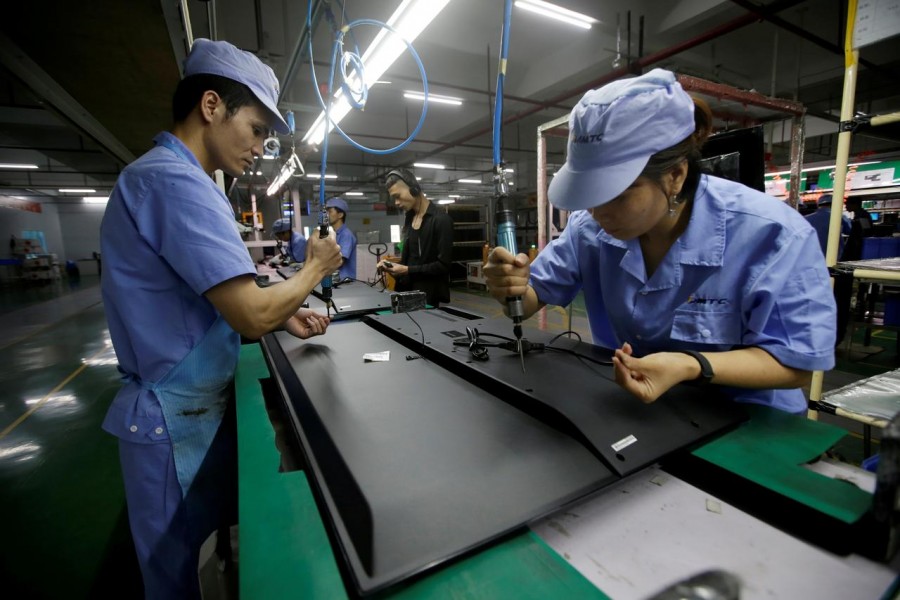China’s factory output growth slowed significantly more than expected in October, as weakness in global and domestic demand and the drawn-out Sino-US trade war weighed on broad segments of the world’s second-largest economy.
Industrial production rose 4.7 per cent year-on-year in October, data from the National Bureau of Statistics released on Thursday showed, below the median forecast of 5.4 per cent growth in a Reuters poll and slower than September’s 5.8 per cent.
Indicators showed other sectors also slowed significantly and missed forecasts with retail sales growth back near a 16-year trough and fixed asset investment growth the weakest on record.
The disappointing numbers show China off to a rough start in the final three months of 2019 and will bolster calls for Beijing to roll out fresh support after third quarter growth slowed to its weakest in almost three decades, with factory production bruised by the trade war with Washington.
Asian stocks fell after the soft data, which reinforced concerns the trade war was hurting one of the world’s major drivers of economic growth.
“These data support our view that growth headwinds remain strong and the economy has yet to hit bottom,” said Nomura in a note, adding that GDP growth is expected to slow to 5.8 per cent in the fourth quarter from 6.0 per cent in the third quarter.
Broad activity in China’s factory sector remained weak in October with producer prices falling at their fastest pace in more than three years and manufacturing activity mired in contraction for a six straight month, recent indicators showed.
Thursday’s data showed the value of delivered industrial exports fell 3.8 per cent on-year in October, marking the third straight month of declines.
China’s steel output fell to a seven-month low in October while the cement production contracted for the first time in over a year, compared with a year earlier.
The tariff war between China and the United States has hit global demand, disrupted supply chains and upended financial markets.
Other major trading powers have also felt the blow from the dispute with Japan’s economy grinding to a near standstill in the third quarter, posting its weakest growth in a year.
While some signs of recent progress in trade negotiations between the superpowers have cheered financial market, officials from both sides have so far avoided any firm commitments to end their dispute.
That uncertainty has weighed persistently on manufacturers and their order books in recent months and raised doubts about the prospects of any breakthrough.
“Even if a minor deal is agreed upon in the coming months, this would merely allow the focus to shift to the more intractable issues that we think will eventually lead the trade talks to break down,” Capital Economics China Economist Martin Lynge Rasmussen said.
Record-low investment
Fixed asset investment, a key driver of economic growth, rose just 5.2 per cent from January-October, against expected growth of 5.4 per cent and the weakest pace since Reuters record began in 1996.
Infrastructure investment rose 4.2 per cent in the first 10 months, slowing from a 4.5 per cent gain in January-September.
In a bid to stop this trend, China’s State Council on Wednesday pledged to lower the minimum capital ratio requirement for some infrastructure investment projects.
At the same time, local governments are facing increasing fiscal strains as tax cuts and the broader slowdown reduce revenues, hampering the big infrastructure projects Beijing needs to revive growth.
Meanwhile, China’s property investment and sales growth both eased to three-months low in October, suggesting a critical pillar of the economy is softening.
Retail sales rose 7.2 per cent year-on-year in October, missing expected growth of 7.9 per cent and matching the more than 16-year low hit in April.
Consumers have been hit with higher food prices over the past few months, as pork and other meat prices soared. For October, they bought fewer garments, jewellery, automobiles from a year earlier.
Support on the way
To prop up growth, China’s central bank this month cut the interest rate on its one-year medium-term lending facility loans, a key policy rate, for the first time since early 2016.
Analysts said the cut, while modest, may be a sign the central bank is becoming more proactive and looking to ease worries that higher inflation will prevent it from delivering fresh stimulus.
“Economic performance still faces a fairly large number of risks and challenges and these cannot be underestimated. In the next stage, we will...continue to fully implement counter-cyclical adjustment policies,” statistics bureau spokeswoman Liu Aihua told reporters in a briefing.
Earlier this week, Premier Li Keqiang flagged the need for the more effective use of economic support tools, such as “counter-cyclical adjustments” and local government special bonds.
In a front-page editorial on Thursday, the state-owned Securities Times said authorities should tolerate longer-term increases in China’s debt-to-gross domestic product ratio to allow for changing economic conditions.


